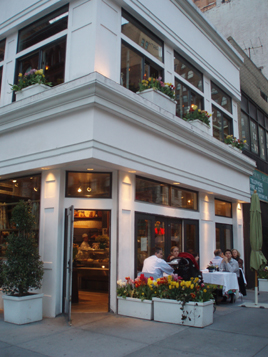Not About the Food?
 Wednesday, July 7, 2010 at 04:41PM
Wednesday, July 7, 2010 at 04:41PM I’d like to deconstruct and debunk a sentence from Sam Sifton’s blog post about this week’s restaurant review, Kenmare. It’s a small point, but that’s why we’re here, so be forewarned.
Here is what Sifton said, with the offending sentence in bold.
I don’t like it much as a restaurant, but that may hardly matter. Places like Kenmare aren’t really about the food. They’re about who’s there and whether they know you. It’s a big city. That works for some people.
“Not about the food” is a lazy meme often trotted out by foodies, food writers, and food-boardists. The restaurants tagged with that epithet are usually those: A) Where the food isn’t very good; and B) That attract a “scene” (models, celebrities, nightclubbers), consisting of people that are somehow determined not to care what they’re eating.
I’d like to challenge that.
In the first place, I think there are very few places that actually set out to serve “inconsequential” food (Sifton’s word). Joey Campanaro, the named chef at Kenmare, has seven New York Times stars to his credit, including a couple of deuces at places where he is still on duty, the justly acclaimed Little Owl and Market Table. I doubt that they would have hired him if they didn’t want a bit of his pixie dust, and I doubt that he would have signed on if knew the food was doomed to be panned—as it has been.
If Kenmare is serving bad food, it’s not by design. Cooking, like books, plays, albums, paintings, and every other kind of creative endeavour, fails sometimes. But rarely is it because the creators never actually cared whether they succeeded.
A commenter to Sifton’s blog post put Pulino’s in the same category, i.e., “not about the food.” But the same owner’s Minetta Tavern has three Times stars and a Michelin star. It throbs with celebrities and pretty young things. Did Keith McNally intend for Pulino’s to be bad (assuming that’s true)? Of course not!
Now, you might argue that regardless of the owner’s intentions, restaurants can be characterized by what their customers intend. But how, exactly, do you put all of Kenmare’s customers into the same bucket? Surely it has (or had) patrons like me, who had enjoyed Joey Campanaro’s work at other restaurants, and wanted to see if he could perform the same magic in another setting.
Visit Sifton’s review, and at the top of it you’ll find a photo of six young, attractive women sitting at a table with drinks, and no food. The caption says, “Kenmare’s owners say it is not a nightclub, but not everyone is going there to eat.”
The women, no doubt, have less experience than Sifton—in the food department, I mean. But who’s to say that, because they are young and attractive, they do not care if they’re served terrible food. (I am assuming the photographer caught them before the food arrived, not that they didn’t order any.) The Times has no idea whether these women ever returned to Kenmare. It just assumes that because of what they look like, they couldn’t possibly tell a good restaurant from a terrible one.
Am I the only one offended by the suggestion?
A couple of Sifton’s other examples—Carmine’s, which has just closed after 107 years at the South Street Seaport; and Nello’s, which received a New York Times goose egg several months ago—seem to me entirely different kinds of places than Kenmare. These are old established restaurants that, for good or ill, have a clientele built up over years or decades that likes what they’re doing, and doesn’t see any need for change.
But Kenmare, a brand spanking new place with a well known chef, has no regulars to fall back on, and the so-called “scene”—those who visit places simply because someone told them to—have a predictable habit of moving on after a few months, or a year at the most. No sensible operator would open such a place intending to serve bad food. That it happens is simply because restaurants fail sometimes.










